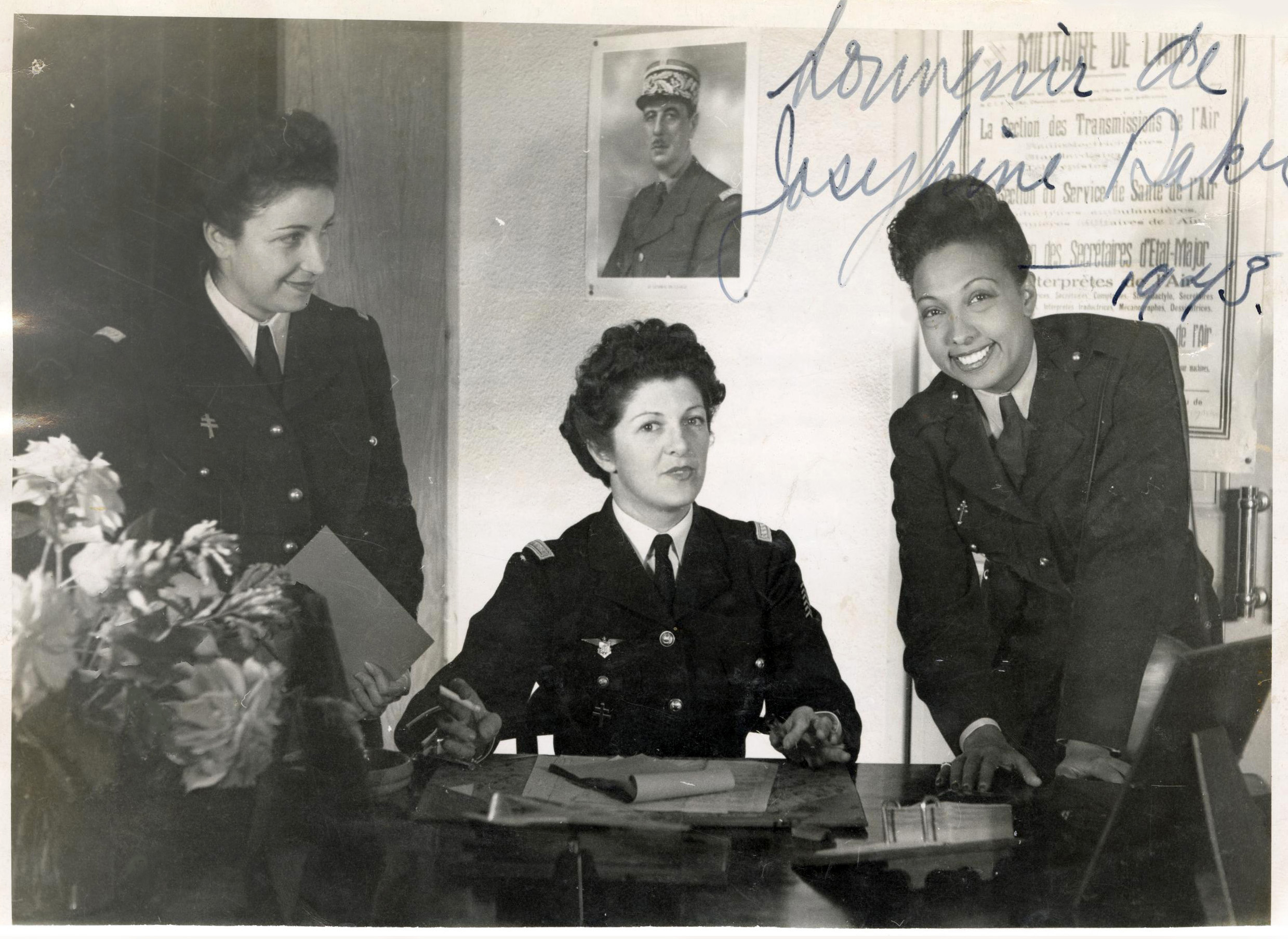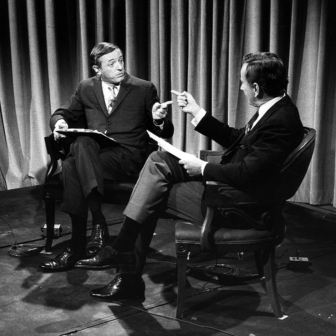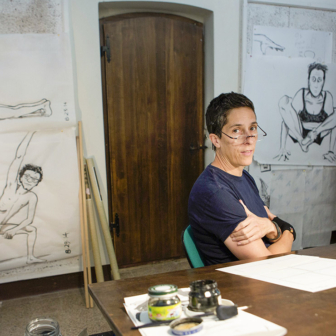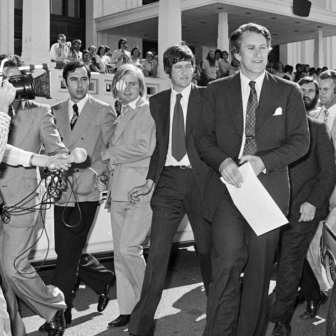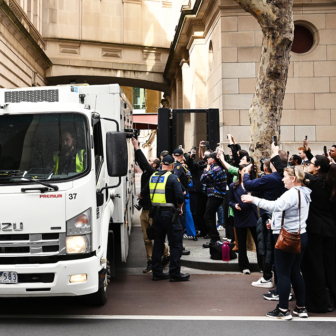When Josephine Baker’s ashes were transferred to the Panthéon in Paris on 30 November 2021 many French people were surprised. Why would an American-born performer, known mainly for her energetic performances in the newly adopted music halls of 1920s Paris, take her place among the nation’s “great men”?
Baker was famous during the interwar period for her contribution to La Revue Nègre, a revue combining jazz, the Charleston and an African aesthetic, and her scandalous “banana skirt” dance at the Folies Bergères. The gossip papers made headlines from her eccentricities — her menagerie of animals, including a pet cheetah, and her “rainbow tribe” of twelve children adopted from eight countries. After her death in 1975 she became an almost forgotten symbol of the imaginary Paris embodied in her famous song “J’ai Deux Amours… Mon Pays et Paris” (I have two loves… my country and Paris).
Yet here she was, being honoured in the Panthéon alongside Voltaire, Victor Hugo and, most recently interred, Robert Badinter, the lawyer and human right activist who campaigned successfully against the death penalty.
In her new book, Josephine Bakers’ Secret War, Hanna Diamond explains why French president Emmanuel Macron granted her the recognition due to a national hero. Focusing on the years 1939–45, Diamond, a professor of French history at Cardiff University, meticulously retraces Baker’s career as a highly effective wartime agent who used her celebrity as the perfect cover for her espionage.
Baker, who was born in St Louis, Missouri, settled in France 1925. She soon dominated the country’s cabarets with her radiant smile and sense of humour, embodying a colonial pastiche and using provocative costuming and nudity to enhance her impact. She entertained the Paris elite at a villa in Le Vésinet sufficiently vast to accommodate her menagerie.
Baker survived the 1929 financial crisis by cleverly shifting from musical hall to talking cinema and radio, becoming one of Europe’s first black international superstars. But although war was threatening in 1939, she decided to stay in France. She had obtained French citizenship in 1937 through her marriage to Jean Lion, a Jewish Paris-based broker. Wishing to “give back to France,” she sang for the troops at the front after the war began, and flatly refused to perform for Germans in Nazi-occupied Paris.
But she was keen to serve her adopted country more deeply. Soon she was contacted by Captain Jacques Abtey, a French intelligence agent who became her informal handler. Hiding in plain sight, she proved invaluable to the war effort.
Abtey led Baker on a solitary trajectory. Neither of them belonged to any of the official resistance organisations or networks catalogued after the war, and nor was Baker listed as an agent of the Free France Intelligence Service or, after its formation in 1942, the Central Bureau of Intelligence and Action. Diamond has had to piece together her undercover career from a range of other sources.
When the Germans marched into Paris, Baker reluctantly left the capital and took refuge in the Dordogne. She agreed to travel to Lisbon, with Abtey posing as her accompanist, to communicate crucial information to British intelligence, with whom France had lost contact since the Vichy regime took power. She then travelled to Marseille to report to the clandestine organisation led by Captain Paul Paillole.
From there, Baker was sent to Morocco during a period of heightened German presence and mounting espionage activity. Under the aegis of the secret services, she travelled from Marrakech, where she was based, to Lisbon, Madrid, Seville and Barcelona, and then round north Africa, giving concerts and attending receptions despite bouts of poor health — all the while gathering top secret information and passing it on to Allied agents.
Although the exact nature of Baker’s intelligence communications is not always known — information was often pinned to her clothes to evade suspicion — Diamond’s research suggests that it proved hugely valuable on several occasions and was sometimes critical. Diamond draws on numerous documents to narrate the story as accurately as possible, highlighting inaccuracies and errors — particularly incorrect dates and locations — in sources including Abtey’s memoirs, published as early as 1948, and Baker and Bouillon’s semi-autobiography published in 1976.
Baker proved an ideal spy for the Americans as well, becoming a key intermediary between the French, Americans and Moroccans during 1943 and 1944. Her network of contacts among influential Moroccans (including Mohammed Menehbi, the brother-in law of the powerful Pasha of Marrakech) facilitated her undercover work and her contribution to the Allied landings in 1944.
Working with the Americans gave Baker an opportunity to perform with African-American soldiers and challenge racism in the army. She helped Sidney Williams, an American civil rights pioneer with the Chicago Urban League, to set up the Liberty’s Club canteen, which organised concerts for Allied troops under the aegis of the Red Cross.
Despite her health struggles, Baker was acutely aware of the importance of entertainment for troop morale. She performed relentlessly on improvised, open-air stages, her capacity to move between different social groups placing her in an extraordinary position: “Not only did it allow her to serve her ambitions to bring people together,” writes Diamond, “but it also gave her access to intelligence.” But she remained subject to racist attacks, demonstrating remarkable self-sacrifice for the cause.
With France’s colonial authority under threat in Africa, Baker promoted public recognition of Free France leader Charles De Gaulle, who had little American support. Her devotion to the cause of the Free France was unwavering. She organised a spectacular gala in Algiers attended by De Gaulle himself, with whom she maintained a correspondence until the end of the 1960s. She toured North Africa with Menehbi, under French military orders. At the end of every performance, she displayed a huge French flag exhibiting the Cross of Lorraine, De Gaulle’s symbol, and raised benefits for the Resistance during the tour.
As noted by Diamond, “Baker was able to evoke the very essence of France and its culture among all those present, reminding them forcefully of her country’s importance and its powerful past, and to equate it directly with the Gaullist cause.”
In May 1945, Baker was officially enlisted as a second lieutenant propaganda officer in the auxiliary services of the Women’s Air Force before returning to mainland France. There, she continued to tour, and to apply what she had learned during the war, effectively harnessing her celebrity to protest against the racial segregation policies of her native country.
Diamond details the awards Baker received, and the difficulty she faced in defending her war record and receiving recognition for her war service. She was given the Resistance medal “with rosette” (in a Neuilly clinic as she was again severely ill) as early as 1946; in a personal letter, de Gaulle thanked her for her service and “the enthusiasm with which she had dedicated her talent to the cause of the Resistance.” But only in 1961 did she receive the Croix de Guerre with one Palm and the Legion of Honour for her service.
As her ten-page bibliography and thirty-four pages of referenced notes shows, Diamond has analysed the archival record thoroughly. Her book is agreeably illustrated with thirty-two photographs and two maps.
But the text can at times be challenging to follow. Readers may become lost in the internal fights between Gaullists and Giraudists and the political and diplomatic nuances of the period. There are occasional repetitions, and some biographical details remain unclear — for example the exact number of Baker’s marriages and to whom. Certain gaps in the narrative are puzzling: how could a woman who “could hardly read or write” upon her arrival in Paris publish her autobiography in 1928 at the age of twenty-one?
Diamond’ s book contributes to a movement that has slowly begun to recognise the courage of an artist who was also a feminist, a woman who actively resisted Nazi Germany while fighting against racism and antisemitism. Baker featured in the Dictionnaire des Étrangers qui ont fait la France (Dictionary of foreigners who made France), published in 2013. The same year, in an article for Le Monde, writer and philosopher Régis Debray called for her admission to the Panthéon, arguing that this American black woman, a libertarian and member of the Resistance, might “bring turbulence and sunshine into this cold crypt.” A few years later, a petition “Osez Joséphine” (Dare with Joséphine) — building on a famous song title by French singer Alain Bashung — was signed by almost 38,000 people.
Baker’s activism continues to resonate today. Having finally emerged from the shadows — and the limelight of the music-hall — she has joined the ranks of Geneviève De Gaulle-Anthonioz and Germaine Tillon, both brave heroes of the Resistance. Hanna Diamond shows how her place among France’s greatest figures is thoroughly deserved. •
Josephine Baker’s Secret War: The African American Star Who Fought for France and Freedom
By Hanna Diamond | Yale University Press | $51.95 | 352 pages
